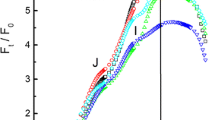Summary
A search was made for DNA in both the basal bodies (BBs) in situ and BBs isolated from cells ofChlamydomonas reinhardtii by high-resolution epifluorescence microscopy after staining with 4′-6-diamidino-2-phenylindole (DAPI), by fluorimetry using a video-intensified microscope photon-counting system (VIMPICS) and by immunofluorescence microscopy after staining with a monoclonal tubulin-specific antibody. The flagella and intracellular microtubules radiate from the BBs. The BBs in young vegetative cells, gametes and young zygotes do not emit fluorescence after staining with DAPI but the spherical cell nucleus, the ovoid chloroplast nuclei and the tiny mitochondrial nuclei emit bright, blue-white fluorescence. Thus, it appears that BBs do not contain larger amounts of DNA than do the other organelles. To avoid the halation effects of fluorescence from the cell debris and cytoplasm and to measure carefully any extremely low levels of DNA that might be present in the organelles, a complex, composed of two flagella, a pair of BBs and the cell nucleus, was isolated from the gametes by treatment with autolysin and 0.1% Triton X-100. After staining with DAPI, the BBs of such complexes exhibit faint fluorescence while the cell nucleus emits strong fluorescence. The point and total intensities of the fluorescence emitted from each portion of the complex were measured with the VIMPICS. When the fluorescence intensity “T” of T 4 phage is taken as a standard, the fluorescence intensities of the flagella, the pair of BBs, the cell nucleus and the nucleus ofEscherichia coli are respectively 0.2 T, 0.40 T, 1452.2 T and 20.4 T. The slight fluorescence emitted from the BB seems to be due to the halation of the fluorescence emitted from the cell nucleus. The intensity of the fluorescence from the BBs is reduced to the intensity of the fluorescence of the flagella when the cell nucleus is removed from the complex. From these results, we conclude that the BBs do not contain DNA. Discrepancies related to the reported presence of DNA in the BBs are discussed.
Similar content being viewed by others
References
Birky Jr, CW, Katko O, Lorenz M (1984) Cytological demonstration of chloroplast DNA behavior during gametogenesis and zygote formation inChlamydomonas reinhardtii. Curr Genet 8: 1–7
Brigati DJ, Myerson D, Leary JJ, Spalholz B, Travis SZ, Fong CKY, Hsiung GD, Ward DC (1983) Detection of viral genomes in cultured cells and paraffin-embedded tissue sections using biotinlabeled hybridization probes. Virology 126: 32–50
Claes H (1971) Autolysie der Zellwand bei den Gameten vonChlamydomonas reinhardtii. Arch Mikrobiol 78: 180–188
Coleman AW, Maguire MJ (1983) Cytological detection of the basis of uniparental inheritance of plastid DNA inChlamydomonas moewusii. Curr Genet 7: 211–218
Edelman M, Schiff JA, Epstein HT (1965) Studies of chloroplast development inEuglena. XII. Two types of satellite DNA. J Mol Biol 11: 769–774
Fulton C (1971) Centrioles. In: Reinert J, Ursprung H (eds) Origin and continuity of cell organelles. Springer, Berlin Heidelberg New York, pp 170–221
Hall JL, Ramanis Z, Luck DJL (1989) Basal body/centriolar DNA: molecular genetics studies inChlamydomonas. Cell 59: 121–132
Heidemann SR, Sander CR, Kirschner MW (1977) Evidence for a functional role of RNA in centrioles. Cell 10: 337–350
Kuroiwa T, Nakamura S (1986) No effect of preferential digestion of chloroplast genome of male origin on chloroplast genome of female origin in young zygotes ofChlamydomonas reinhardtii as revealed by a video-intensified microscope photon-counting system. Histochem Cytochem Acta 21: 95–103
—, Suzuki T (1980) An improved method for the demonstation of thein situ chloroplast nuclei in higher plants. Cell Struct Funct 5: 195–197
—, Nishibayashi S, Kawano S (1981 a) Visualization of DNA in plant mitochondria, various phages and single DNA molecules by epifluorescence microscopy. Proc 13th Int Bot Congr Sydney 13, 250 a
— — —, Suzuki Z (1981 b) Visualization of DNA in various phages (T4,x, T7, 029) by ethidium bromide epifluorescent microscopy. Experientia 37: 967–970
—, Kawano S, Nishibayashi S, Sato S (1982) Epifluorescent microscopic evidence for maternal inheritance of chloroplast DNA. Nature 198: 481–483
—, Nakamura S, Sato C, Tsubo Y (1985) Epifluorescent microscopic studies on the mechanism of preferential destruction of chloroplast nucleoids of male origin in young zygotes ofChlamydomonas reinhardtii. Protoplasma 135: 43–52
—, Miyamura S, Kawano S, Hizume M, Toh-e A, Miyakawa I, Sando N (1986) Cytological characterization of NOR in the bivalents ofSaccharomyces cerevisiae. Exp Cell Res 165: 199–206
Lewin RA, Lee KW (1985) Autonomy of algal flagella: electron microscope studies ofChlamydomonas (Chlorophyceae) andTetraselmis (Prasinophyceae). Phycologia 324: 311–316
Lima-de-Faria A (1986) Molecular evolution and organization of the chromosomes. Elsevier, Amsterdam
Nakamura S, Kuroiwa T (1989) Selective elimination of chloroplast DNA by 5-fluorodeoxyuridine causing no effect on preferential digestion of male chloroplast nucleoids inChlamydomonas. Eur J Cell Biol 48: 165–173
Pyne CK (1968) Sur l'absence d'incorporation de la thymidine tritiee dans les cinetosomes deTetrahymena. Comp Rend Acad Sci (Paris) 267: 755–757
Rampton VW (1962) Kinetosomes ofTetrahymena. Nature 195: 195
Randall JT, Disfbrey C (1965) Evidence for the presence of DNA at basal body sites inTetrahymena pyriformis. Proc R Soc Lond [Biol] 162: 473–491
Sagan L (1967) On the origin of mitosing cells. J Theoret Biol 14: 225–274
Sager R (1972) Cytoplasmic genes and organelles. Academic Press, New York
—, Granick S (1954) Nutritional control of sexuality inChlamydomonas reinhardtii. J Gen Physiol 37: 729–742
Smith-Sonneborn J, Plaut W (1967) Evidence for the presence of DNA in the pellicle ofParamecium. J Cell Sci 2: 225–234
Salisbury JL, Baron A, Surek B, Melkonian B (1984) Striated flagellar roots: isolation and partial characterization of a calciummodulated contractile organelle. J Cell Biol 99: 962–970
Uyeda TQP, Furuya M (1985) Cytoskeletal changes visualized by fluorescence microscopy during amoeba-to-flagellate and flagellate-to-amoeba transformations inPhysarum polycephalum. Protoplasma 126: 221–232
Wheatley DN (1982) The centriole: a central enigma of cell biology. Elsevier, Amsterdam
Author information
Authors and Affiliations
Rights and permissions
About this article
Cite this article
Kuroiwa, T., Yorihuzi, T., Yabe, N. et al. Absence of DNA in the basal body ofChlamydomonas reinhardtii by fluorimetry using a video-intensified microscope photon-counting system. Protoplasma 158, 155–164 (1990). https://doi.org/10.1007/BF01323128
Received:
Accepted:
Issue Date:
DOI: https://doi.org/10.1007/BF01323128




